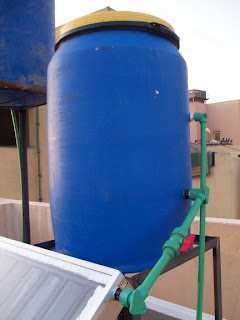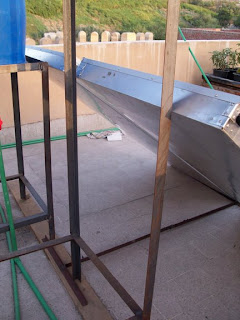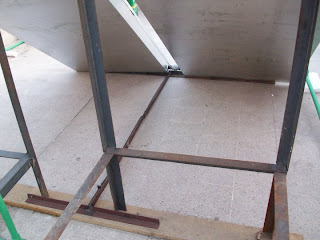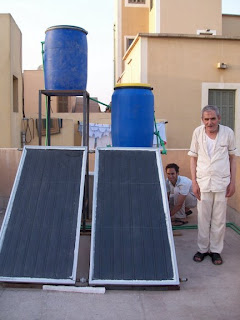 (Solar C3ITIES first intern, Freiburg social sciences student Cornelia Koeck, cutting aluminum sheets in Hanna Fathy's Zabaleen apartment solar energy workshop. All Photos in this post by Connie Koeck.
(Solar C3ITIES first intern, Freiburg social sciences student Cornelia Koeck, cutting aluminum sheets in Hanna Fathy's Zabaleen apartment solar energy workshop. All Photos in this post by Connie Koeck.)
Solar C
3ITIES is happy to announce that our first official intern since we became a legal German "Verein" (NGO) has returned to Germany after a successful summer in Cairo.
Ms. Cornelia "Connie" Koeck, a 25 year old student of Social Science at Albert-Ludwigs-University in Germany's premier solar city, Freiburg, spent the hot summer months working with Solar C
3ITIES' Green Collar Jobs Trainer Hanna Fathy building solar hot water systems on the rooftops of buildings in Muqattam and Darb Al Ahmar in the slums and informal areas of Cairo, Egypt.
Connie's assignment was what we call "The Solar C
3ITIES Solar Challenge": Learn
how to build -- and then
actually build ! -- a practical solar hot water system -- from scratch, out of local and recycled materials found in small mom-and-pop markets and in garbage dumps -- and install it on the home of at least one poor Cairo family. Her "aufgabe" (homework): Create a clear, illustrated manual in her native language (to be translated into English and Arabic) that could help others around the world to do the same thing.
(Connie's First Solar Hot Water System near the Darb Al Ahmar Mosque).
The Solar C
3ITIES Challenge follows the modified motto "Force somebody to buy a fish and you will have fed him for today but made him poorer for tomorow ; Learn how to fish and share the knowledge with your friends and you create a skilled social network that can provide enough for all in both good and bad times."
This spring Solar C
3ITIES will launch its "Urban Bountiful Biogas Challenge", as T.H. and Sybille head back to Cairo to figure out how to turn city garbage into clean cooking and heating fuel and fertilizer, servicing families who have no access to direct sunlight. But we are getting ahead of ourselves...
Beyond the "Rule of Experts"
Connie took a train from Berlin to Essen to meet with us before embarking on her trip overseas and expressed her concerns and her resolve, "I'm a social science student" she said, "and I have no practical experience with engineering, physics or with building things. But I'm willing to get in there and give it a try."
She was encouraged by the fact that T.H. Culhane, co-founder of Solar C
3ITIES , and co-inventor of our signature "Plastic-Barrel Solar Hot Water System" was also a mere social science student (a Ph.D. candidate in Urban Planning, Environmental Policy and Analysis at UCLA), who also had absolutely no background or supervised experience in engineering or physics. T.H. told her, "the intelligence is in the network. We operate according to the distributed intelligence principles of "swarm" or "hive" intelligence. Somewhere in every community are nodes of specialized brilliance -- a local welder or mechanic or plumber or carpenter or waste recycler. You go in as a community catalyst, connecting other community catalysts and hooking up and organizing the social network of skilled participants toward a common goal. Then you learn from each other as you get the job done."
Based on this philosophy Solar C
3ITIES created the C
3ITIES acronym that serves as our mission statement: "Connecting Community Catalysts Integrating Technologies for Industrial Ecology Systems".
The Solar C
3ITIES mantra is that ALL OF US can acheive domestic energy independence, regardless of our backgrounds or educational specializations. The idea behind our program has been that if normal people LIKE US can kick the addiction to fossil fuels, all you hockey moms and joe-six-packs and public policy makers and Harvard Law School graduates NOT TO MENTION ALL THE "JOE THE PLUMBERS" (who already know about water and energy infrastructure) can too -- with your own two hands (and those of your community) and without drilling one-more drop of oil, to say nothing of splitting atoms or mining coal. Once you feel the power that comes from working on the household level with friends and neighbors to solve your own energy crises, you realize that we don't really need "governments" or expensive "consultants" or "specialists" or "big businesses" to solve our problems, just the collective intelligence of human beings sharing a common purpose.
The Results:
Connie photographed Solar C3ITIES green collar jobs coordinator, Zabaleen innovator Hanna Fathy (center), who trained Connie, describing a system he built next to Al Azhar park to British-American micro-finance expert Rosalind Copisarow and an Egyptian journalist.
Connie returned to Germany a solar hot water engineering expert. She built her solar hot water system on the rooftops of Cairo and created the training manual she set out to make (which will be available soon). Below are some of the diagrams she produced, which we reproduce here so that any of you out there in the blogosphere who want to get started on your own energy independence project can do so:
Tools you'll need:
The schematics:
Figure 1 shows the water flow of our two tank system. Note that our innovation is that we use OPEN (although covered to prevent heat loss and evaporation) vertical tanks. Note that the blue arrow inside tank B, the hot water tank, is actually a polypropylene pipe carrying the cold water to the bottom of the barrel.
Figure 2 shows the critical placement of the two recycled plastic shampoo barrels that make up our system, giving maximum flow and thermosiphoning.
Figure 3 shows the critical placement of all the pipes and float valves in the system. After a year of experimentation T.H. Culhane and Hanna Fathy discovered that these were the correct dimensions for a system that uses 3/4" Zahran tank float valves to work during the winter months. We suggest, if you aren't an engineer, that you follow these measurements exactly (unless you really want to experiment and can find an improvement).



(Note: We use the less expensive 1/2" Zahran float valve (picture left) for the cold water tank because we aren't concerned about flow rate filling the tank with cold water, which only occurs when the neighborhood has water pressure anyway (the soap suds in the picture are because we use recycled shampoo barrels that always have residue of shampoo in them. It is safer than using barrels that contained chemicals, and you don't have to wash them out. For the first few days you also don't have to use shampoo!) For the hot water tank (picture right) we use the larger 3/4" float valve between the cold water inlet and the hot water tank (note the green 3/4" polypropylene pipe descending to the bottom of the tank) so that water flows in as fast as it flows out through the 1/2" outlet to the household shower. We found that due to the long drop to the household the water would drain faster than it was being replaced if both were 1/2". The disadvantage, though, is that the 3/4" float is very large and takes up space that could be used for hot water. We sacrifice about 25 liters because of this. A better solution would be to find a way to use the float from the 1/2" valve with the mechanism from the 3/4" system, but they do not work together. Inventor Magdy Zahran tells us that a redesign would require expensive retooling and the market for do-it-yourself solar systems is of course too small. So it appears we are stuck with this compromise!)
Figure 4 shows the Zahran plastic tank nipple and the photographs show the Zahran float valves, 1/2" for the cold water tank and 3/4" for the hot water tank. We used to use metal nipples with rubber gaskets and steel pressure plates, but they tend to rust and the metal wears away at the plastic of the barrel, eventually leaking if too much stress is placed at the join.
Figure 5 shows how we insulate the hot water barrel (which is otherwise identical to the cold water barrel) by creating a styrofoam box and filling it with waste bits of styrofoam and fiberglass, wool, scraps of paper etc. to kill airflow. Note that we first wrap the tank with shiny mylar or aluminum foil, then bubble wrap, tehn another layer of mylar, to keep heat internally reflecting.
Figure 6 shows the construction of the solar collector itself. This is fairly standard: a box made of 1 mm aluminum sheets (1 x 2 meter, bent into a box) filled with styrofoam sheet insulation on the back and the sides, with welded copper pipe attached to guttered aluminum strips painted black, covered with glass, with special sauce on a sesame seed bun. We've also made the collector box out of wood and recycled pressed plastic sheets, but aluminum is the quickest, easiest and lightest. We make our absorber plates out of aluminum strips (preferred) but we've also made them out of recycled butter tins, soda cans and other thin scrap metal. When all is said and done, we find it simplest to buy 1 mm 1x2 aluminum sheeting for the box and .5 mm aluminum sheeting for the absorber fins to save on labor and for durability.




Figure 7 shows how we connect the panels in series, using screw couplings, allowing the system to expand with additional family members (we recommend a two panel system for a family of 4, with an additional panel for every additional 2 family members; each panel puts out approximately 100 liters of bath temperature water in the summer, 75 liters in the winter)
Figure 8 Shows the placement of the valves in the system. It is critical that one put a one-way valve before the cold water tank inlet (not shown) to keep water from backflowing when there is no water pressure (a daily occurence in inner-city Cairo). Another one-way valve is needed somewhere along the hot water outlet pipe to the house to prevent water cold water from backflowing into the hot water tank if the plumbing in the household isn't properly done (as is often the case). Too often, in a country with bad materials like Cairo, a family's faucet mixer will break and the cold water will go up the hot water pipe and flood the roof if there is no one way valve. We recommend AGAINST placing the valve as shown in the picture, so close to the tank because their isn't sufficent pressure to open it. A better placement is actually IN the bathroom, where it can easily be serviced, or at least at the lowest accesible point on the roof before the hot water pipe goes down to the household.




Many old people in the community risk their lives boiling water for bathing on kerosene and gas stoves. Accidents from explosions and scalds from spilled hot water send hundreds of children and elderly residents to the hospital every year. Now this old gentleman (above right) never has to worry about his safety, or the increasing struggle to carry buckets of hot water to the bathroom again. Furthermore, and very imporant to an old pensioner with no income, he never has to pay to heat his water again!
Hanna Fathy, green collar trainer of trainers, shows Connie step by step how to build a Solar C3ITIES system.
Trainer of Trainers
Our successful Solar C
3ITIES intern, Cornelia Koeck, is now a Solar C
3ITIES expert and can now become a trainer of trainers. We certainly don't expect her or anyone to spend their lives on slum rooftops building solar hot water systems. Our green collar jobs training program assumes that some folks on our "Planet of Slums" will decide to create lucrative businesses out of domestic renewable energy programs. This is particularly appropriate for JOE THE PLUMBER in the U.S., and AHMED THE PLUMBER in Muqattam and MOHAMMED THE PLUMBER in Darb Al Ahmar with whom we built our solar hot water systems in Cairo. But we know your average hockey mom or Joe-six-pack or Harvard Law School Grad or Social Science or Urban Planning student will have other priorities. Still, we believe that once you have built a working, practical, inflation-resistent (let us say these days "FINANCIAL CRISIS RESISTENT") energy independence system, you still have one more duty as a concerned Solar Citizen:
Pay it forward!
Pass the knowledge on, help a friend or neighbor or somebody less fortunate than you elsewhere in the world to become energy independent (all of us who are addicted to oil are less fortunate than those who aren't, n'est-ce pas?). Then move on to other challenges (like the Solar C
3ITIES urban bountiful biogas challenge!) and keep moving forward, step by step, community by community, until the threats of wars for foreign oil, the despoiling and degradation of our environments and the destructive potential of climate change become merely scary bedtime stories we will tell our children of the way we were when we were young and naive, back when silly people thought humanity could simply drill our way out of our messes.
-- T.H. Culhane
 (Solar C3ITIES co-founder T.H. Culhane demonstrating solar and fuel-cell technology in Syria on September 11, 2002,on a U.S. State Department tour, meets anti-war protesters and suggests Damascus become a solar city and that the Middle East end its own addiction to fossil fuels and interests in nuclear power as a way to prevent war.)
(Solar C3ITIES co-founder T.H. Culhane demonstrating solar and fuel-cell technology in Syria on September 11, 2002,on a U.S. State Department tour, meets anti-war protesters and suggests Damascus become a solar city and that the Middle East end its own addiction to fossil fuels and interests in nuclear power as a way to prevent war.)
















































